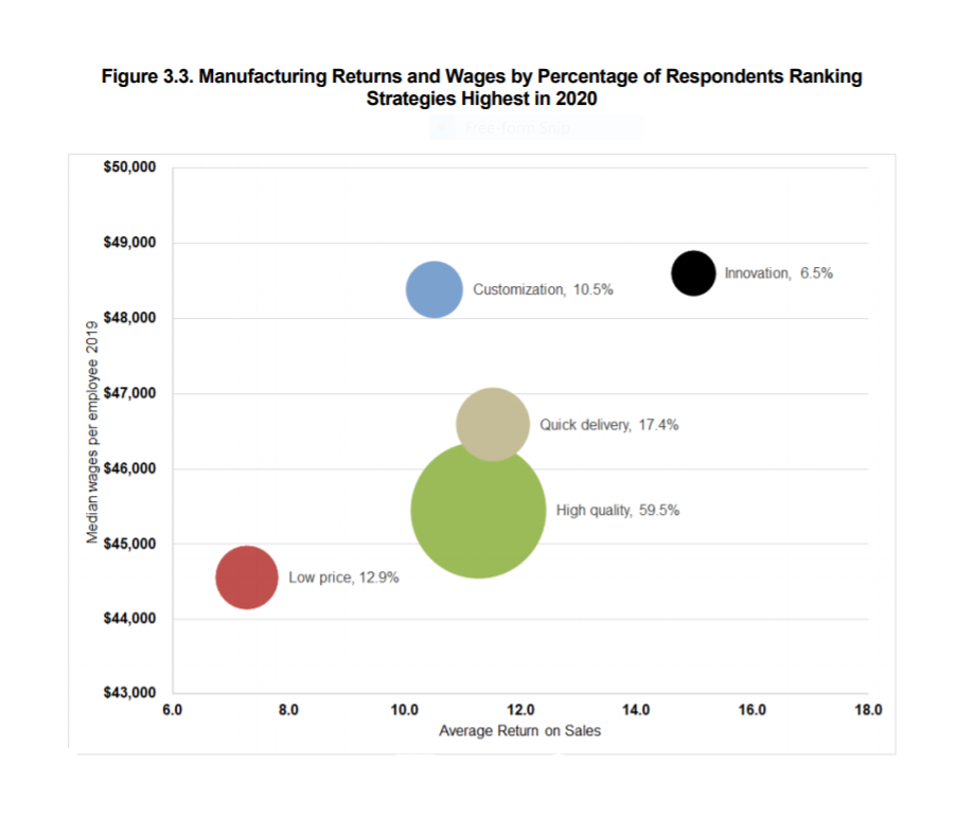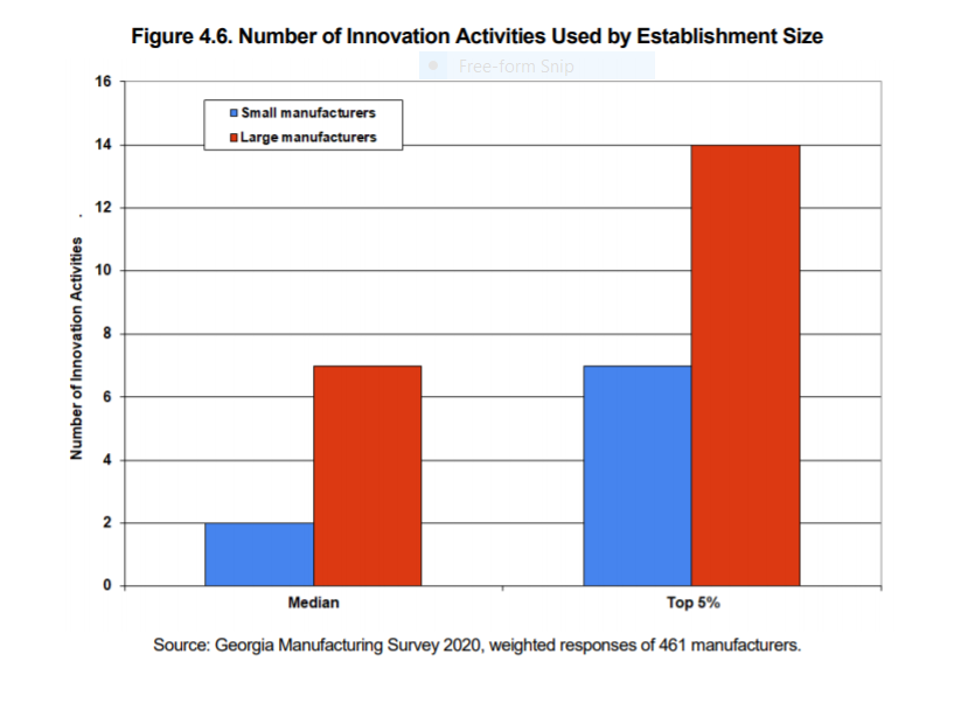Manufacturing Innovation Blog
Powered by the Manufacturing Extension Partnership

The last couple of months have caused manufacturers and MEP Centers to think anew about many things — supplier, customer and workforce relationships; the economy; outsourcing, insourcing, and reshoring; lean; automation; and on and on. Things have changed. A lot. We now see papers, blog posts and other things suggesting the we need to reimagine, rethink, reinvent, rebound, retool and recover as the environment that we face has, in many ways, been turned upside down or at least it feels that way.
I think the 2020 experience also suggests that manufacturers and MEP Centers need to be resilient; in fact, that is the theme of the 2020 Georgia Manufacturing Survey. Manufacturers need to be able to bounce back and chart a new path moving forward. Although the virus was a huge and unexpected shock, resilience in the modern business environment (defined here as a company’s capacity to absorb stress, recover critical functionality and thrive in altered circumstances) will only become more important. The current situation may not last but a number of other stresses on business systems — such as accelerated technological evolution — will, and new ones will emerge that we did not see coming or even anticipate.
In many ways, the last few months represent what some call a moment of punctuated equilibrium in which the typical pattern of incremental (or small) change is no longer appropriate for the current period. Slow and steady may not always be the best fit, and it doesn’t seem to work in the race we’re running now. What follows is a summary of the findings from the Georgia Manufacturing Survey.
Survey Background
Georgia Tech and their partners have conducted the Georgia Manufacturing Survey every two to three years since 1994. The most recent survey provides a look inside what manufacturers are thinking about and implementing as they move forward in this new environment. The 2020 survey focused on the dual themes of resilient and intelligent manufacturing with an emphasis on digital technology use, standards and responses to trade and tariff issues. The survey also included questions about product and business process innovation such as how manufacturers are deploying or planning to deploy manufacturing technologies and techniques within their plants, operational performance and the impact and effectiveness of Georgia’s manufacturing assistance programs. The 2020 survey went to all Georgia manufacturing firms with 10 or more employees. The study received valid responses from 461 manufacturing establishments, which represented a 12% response rate.
Survey Findings
The survey’s results can be categorized into several broad areas, revealing useful insights into what manufacturers are doing or thinking about. There is lot to digest in this report, so I am only touching on some of the high points.
- Challenges and needs. Skills, both basic and technical, and marketing/sales emerged as the most common need or challenge and the share of manufacturers citing them increased in 2020 compared with 2018. Challenges across the areas of management/leadership and cybersecurity also increased between 2018 to 2020. The number of manufacturers reporting lean manufacturing as a need/challenge declined from 2018 to 2020. In addition, needs or challenges around energy costs and environmental/health/safety also declined.
- The effect of trade policies. The survey asked Georgia manufacturers what actions they had taken in response to recent changes in trade and tariff policies. The responses were scattered. More than one third (34%) said they raised prices for their products and thus passed along some or all of the cost increase to customers. What portion of the cost increase was covered by those price increases is not known. Sixteen percent said they made a move to source needed supplies from U.S. based companies and 11% built up their inventory levels as a reaction to changes in tariffs. Less than one in ten (9%) said they sought out other non-U.S. based suppliers.
- Profitability and the payoff to different strategies. The survey measured profitability in terms of average return on sales over the past three years. The average Georgia manufacturer reported that their average return on sales was 11.9%.
Chart One

Source: 2020 Georgia Manufacturing Survey
The chart above suggests that the average return on sales differs across manufacturers in terms of their primary strategy. For instance, nearly 13% of the manufacturers report they compete based on low price and 6.5% compete based on innovation. However, the average rate of profitability for manufacturers competing based on being innovative was twice as high as those that competed based on low price.
- Advanced manufacturing technology deployment and diffusion. Just over eight in ten Georgia manufacturers are using digital technology in their plants. The most prevalent digital tools in use are enterprise resource planning (ERP) as 68% reported using ERP and 63% reported using computer-aided design (CAD). Fewer than 20% of the manufacturers surveyed reported using advanced manufacturing technologies such as robots/cobots, additive manufacturing, augmented reality (AR) tools, or the internet of things (IoT).
- Data security issues. As manufacturers adopt more advanced manufacturing technologies and marry their operation technologies to information technologies, the security of these technologies and safeguarding proprietary information and data becomes a concern. Just under one in four Georgia manufacturers have put data security compliance standards into effect to protect their electronic data from unauthorized or criminal use. The most common data security standard among survey respondents is the European Union’s General Data Protection Regulation (GDPR) compliance standard, reportedly used by 21%.
- Innovation activities. The survey asked a series of questions about innovation activities to capture things like the introduction of new goods or services, process and organization innovations. The report examined the differences in innovation activities across small versus large firms. There is a significant gap between small and large firms.
Chart Two

As this chart shows, the gap between small and large manufacturers in terms of innovation activities is quite large and significant. Larger manufacturers engaged in more than three times as much innovation activity as did smaller manufacturers. Closing this gap may help improve the performance of smaller manufacturers.
Moving Forward
This survey provides a snapshot of the current state of manufacturing in Georgia. It also provides important information for companies to use to help guide their own thinking about how to move their company forward and better understand how to make their company more resilient and able to respond to external shocks. As we are hearing in our national conversations with manufacturers across the country, they are adapting to a new environment that requires modifications across many areas. These conversations have also highlighted the importance of leadership and management to lead as they move forward. Whether these can be generalized beyond Georgia is difficult to say, but the results provide a potential benchmark and present an established survey tool others could adapt and use.
Some MEP Centers are doing their own surveys as well, such as the recent 2020 State of Manufacturing Survey conducted by Enterprise Minnesota. These surveys make it clear things changed in fundamental ways after mid-March of this year for many manufacturers. We all have to find a way forward with the new experiences and knowledge we’ve gained as our guide.


